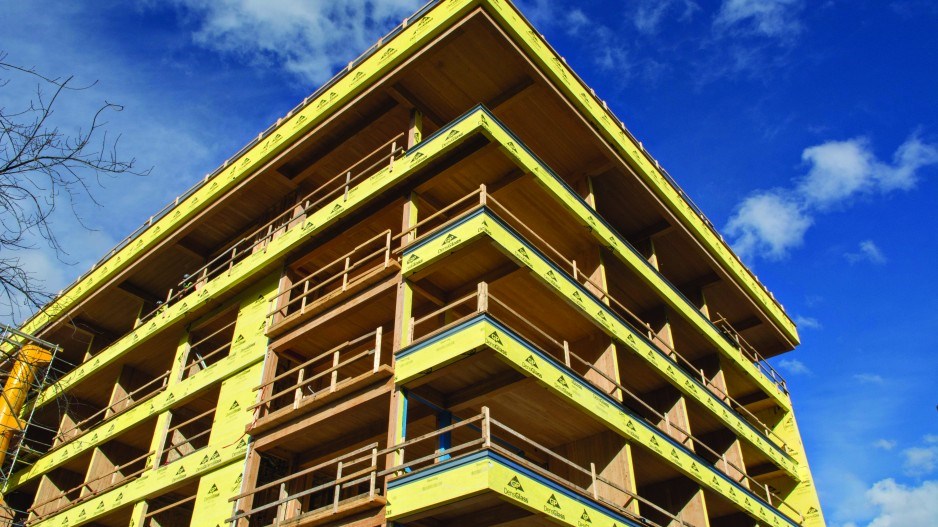An often-heard criticism in B.C., where dozens of sawmills have closed in recent years, is that the province should be doing more value-added manufacturing with its timber, rather than just exporting it as raw logs.
And when politicians want to highlight a success story in B.C.’s value-added wood manufacturing to demonstrate what they’re talking about, they can always point to Structurlam Products Ltd. in Penticton.
Structurlam is indeed a B.C. success story, but it’s by no means an overnight one.
Employing 170 people at its plants in Penticton and Okanagan Falls, the company’s engineered mass timber products have been used in the construction of the Richmond Olympic Oval and the world’s tallest wood building – the 18-storey Brock Commons at the University of British Columbia (UBC).
Several hotels in Western Canada have been built, or are under construction, using Structurlam products, including an expansion underway at the Penticton Lakeside Resort, and the company has even begun to export to Asia.
To date, the Penticton company has been involved in more than 350 projects using the glue-laminated (glulam) and cross-laminated timber (CLT) that it manufactures.
Structurlam’s story started in the early 1960s, when a family-owned business began making glulam, which is regular dimensional lumber glued together to form strong beams and columns that can be used in construction instead of steel.
CLT takes glulam to the next level to make larger blocks for walls, floors and ceilings that would normally be made from concrete or other traditional building materials.
In 2007, B.C. real estate developer the Adera Group bought Structurlam, which later acquired CLT technology from Europe. In 2011, it opened the first CLT plant in North America.
“We basically bought European machinery but adapted it to local fibre supply,” said Stephen Tolnai, vice-president of sales and marketing for Structurlam.
There are an estimated 15 to 20 CLT manufacturers in Europe, but only a handful in North America – two of the biggest being Canadian.
There are good reasons why Structurlam is one of only two CLT manufacturers in Canada. The machinery used to make it is expensive, disruption in the construction industry has been slow in coming and CLT manufacturing is still dominated by manufacturers in Europe, where the process was developed.
“We’ve been fighting tooth and nail for seven years to try and get this product to market and we’re starting to get some traction now,” Tolnai said.
Glulam and CLT are said to be as strong as steel and concrete, but much lighter and more esthetically pleasing, and they have a smaller environmental footprint, because they are made from a renewable resource that stores carbon and takes less energy to make than do steel and concrete.
That’s what persuaded the owners of the Penticton Lakeside Resort to go with wood, rather than concrete and steel, for a new $16 million, 70-unit expansion.
“We were sold on the greenness of it,” said David Prystay, the resort’s general manager. “We were sold on the fact that it’s a local business. We were sold on the fact that it’s a renewable resource grown in British Columbia. We were sold on the green effects on the atmosphere, versus building with concrete, where the wood building is a like a carbon sink. We were sold on the beauty of it.”
Although using glulam and CLT instead of steel and concrete can be slightly more expensive, Prystay said those costs are offset by the swifter construction schedule allowed by glulam and CLT. And because wood is so much lighter than steel and concrete, the new building didn’t require the pilings that otherwise would have been needed.
“It’s a little more expensive but it’s built a lot quicker,” Prystay said.
The Richmond Olympic Oval incorporates glulam made by Structurlam, and UBC’s Brock Commons has both glulam and CLT.
Compared with a traditional sawmill, the upfront costs of a CLT plant are “massive,” Tolnai said. And it’s a fairly high-tech process that requires a team of structural engineers to design the pieces to fit the specifications of a particular building.
“Basically, we deliver a Lego kit to site,” Tolnai said. “We do a full 3D modelling. We virtually construct the building down to the individual screw. It is complete prefabrication.”
Only one other company in Canada makes CLT – Nordic Structures in Quebec. One of Nordic’s areas of specialization is making bridges out of CLT.
However, one other B.C. company, StructureCraft Builders Inc. in Delta, is poised to make its debut in the mass-timber manufacturing business.
The company plans to open a new 50,000-square-foot manufacturing plant in Abbotsford this fall, where it will begin manufacturing dowel-laminated timber.




